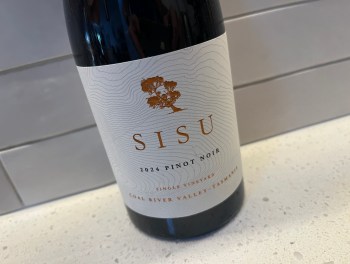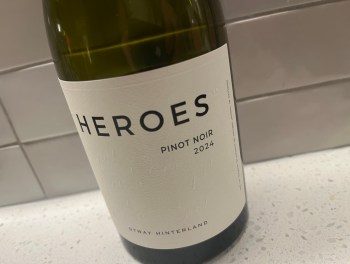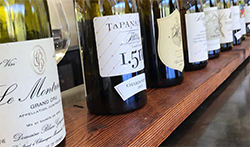So many luxury wines end up as disappointments.
Too often, wines with AUD$100+ pricetags and unfettered ambitions turn out to be bulldust and oak tannins. Wines that speak of ego, of brand positioning and me-tooism rather than any notion of quality.
And every time I wonder ‘who buys this stuff?’.
I’m sorry to say that when I rocked up at the door of Sydney’s new (superb, go there) Woodcut restaurant to try a vertical of Yalumba’s Caley over lunch, I had a tangent of that notion swirling around in my head. Who, I wondered, would shell out $350+ for a bottle of Yalumba red, given the winery’s rep for humble bargains, rather than headturning icons?
To be honest, I still don’t have a clear answer to that. But I know on a quality basis, these wines swing in the same league as contemporaries like Penfolds Bin 707 (and indeed Grange) while retaining a sense of humility that said luxury wines are missing.
Icon level quality from a brand with a storied history.
The Penfoldian comparison doesn’t stop there either. At lunch, the understated Yalumba winemaker-not-wine-marketer Kevin Glastonbury (KG) noted how this wine could taste different to a top Penfolds red because of slight variations in technique.
Now that sentiment was probably lost on a room of wine writers who already know this isn’t a Penfolds wine. But it did give an idea about inspo. And you only need to try some of the grandiose, Cooonawarra Cab/Barossa Shiraz based wines of Penfolds 60A, 90A et al to realise where the outlook lies. Although calling this Penfolds-lite in any way is a slap in the face – Yalumba’s history with Cabernet Shiraz is as long as Penfolds, so this is an expression of classic Australian red, not a half-baked emulation of 60A.
And the expression is very very good.
I was blindsided by the quality. No, that’s the wrong way to describe it. I had the ’12 a while back, and loved the Caley precursor, the somehow forgotten Yalumba Reserve. So I expected fine wine. But I didn’t expect to find myself side-eyeing a bottle of ’16 and hoping that I could take it home…
Actually, let’s talk about how Caley came to be, as spoken by KG himself (although I’m paraphrasing) with the extra context courtesy of the charming (and grounded) Hill-Smith heir-apparent Jessica Hill-Smith.
As KG says (and many will know), 2012 was ‘such a good year’ for the Barossa in particular. And at Yalumba, legendary winemaker Brian ‘Walshy’ Walsh was constantly discussing how the vintage was ‘shining’ and Yalumba didn’t have an icon wine to be showing it off.
At that stage, the 2006 Reserve was just being released, and there was no obvious successor. Naught. No Reserve made from any year after that. Walshy was to retire at the end of that year, and so, effectively the task of what to do was handed over to KG.
For KG, it became something of a natural choice. The 2012 Coonawarra fruit was too good to ignore, so the Yalumba team set themselves a goal to make a Coonawarra Cabernet blend and make it great.
From the outset, the intention was to make the blend at least 70% Cabernet. While that first vintage also ended up being circa 50/50 Coonawarra and Barossa fruit, releases since have been Coonawarra dominant, although with variations according to season as the volumes of fruit change. Caley’s production, in particular, is limited by the Menzies Vineyard capacity, and the Yalumba team don’t want to hollow out Menzies Cabernet either. So clearly this isn’t a big make by any stretch.
Now, about that Penfolds winemaking reference. The barrels for all Yalumba reds are kept at 2 o clock (so the bung is kept more submerged) compared to 12 o’clock at Penfolds. This means less oxygen in the mix, hence less VA and less sulphur added as a result. Theoretically that translates into tighter, more elegant wines, although you might miss the Penfolds punchiness too. Swings and roundabouts.
Another tidbit – Yalumba only uses 5% American oak these days, largely French and with a large proportion of Hungarian oak.
I couldn’t keep up with the flow of useful/interesting contextual bits that Kevin was offering up during the tasting because I was getting sidetracked trying to do the wines justice. Then lunch came out and I was on the back foot further. I blame Woodcut as the detail and rightness of this lunch was memorable, and as a hungry man I ate everything.
In particular, the Rangers Valley Black Angas 1kg T-bone (below) was a carnivore’s wet dream. Something you think about and recreate in your brain and mouth, a cavalcade of texture and perfectly even flavour, highlighting the sort of grill artistry that makes me realise how crap I am at cooking anything.
Anyway, it’s all a footnote. Go eat at Woodcut, it was approaching flawlessness without pretension.
Onto the wines.
As the scores attest, these reds trip over to that quality level where even the most jaded palate can appreciate the lines and style. And sure, the next-level food no doubt makes life enjoyable (call out my bias is you see it). But the best vintages of The Caley are what you want an icon Australian red wine to taste like. Something grand, powerful, yet classy. Something that isn’t trying to be Bordeaux or a Burgundy or Brunello or some other iconic B region.
Laugh and think, this is Australia.
Notes are as written on the day. Extra contextual bits in italics.
Yalumba Caley Cabernet Shiraz 2012
52% Coonawarra Cab, 27% Barossa Cab, 21% Barossa Shiraz. Coonawarra Cabernet is from the Ming D Block. Barossa Cabernet from Simon Cowham’s vineyard near Light Pass. Barossa Shiraz from the Burgemeister Linke Block at Light Pass, and the Horseshoe Vineyard at Angaston. Spent 22 months in 31% new Franch oak.
The first Caley and it’s a different, more Barossan beast. More plumpness through the middle compared to the wines around it. But also more seduction. From the outset, this is a broad-shouldered and full-bodied Australian red. Brick dust and coffee, Some cooked plum, still looks very youthful, even though it’s a lot older in this context. You don’t see the age on the palate, save for some late, earthen polymerised tannin grip. There’s a lovely youthfulness, couched in oak, that I often associate with top Rioja. Such a joyous mid palate. Young but old. Classic Australian red. Maybe a bit plump compared to the more regal wines after it, but more palate volume as a result. The brick dust aged characters build in the glass, but so does the fruit. You can’t avoid the role of oak here – it just pumps up the palate in the right way. High class and ultimately delicious – the complete package. Best drinking: now or in many years to come. I like it now. The plateau will extend at least 15 years more. 18.7/20, 95/100. 14%.
Yalumba Caley Cabernet Shiraz 2013
55% Coonawarra Cabernet, 45% Barossa Shiraz. Spent 20 months in 41% new oak. From the Ming D Block in Coonawarra. Shiraz is a blend from Simon Cowham’s Antique Block (planted 1955) and the Schrapel block in the Tanunda Foothills planted in 1974.
‘KG: From a leaner vintage, the wines were more austere. Less juice, more skin, more tannin. Less aromatic, but still screaming I’m a Cabernet Shiraz’.
Denser, but there’s just a little stressed fruit too. It’s black, deep, you see less oak here, more ripe fruit, more jam, less tannins. It’s a black wine, deep, withering, long, powerful, though not as seductive in context. You could almost have picked this as Shiraz dominant, save for the blackcurrant. Very polished though, and the alcohol doesn’t poke out. Fine, but not sublime. Plush, chunky, so rich but not quite regal. High quality, undoubted. Best drinking: Will it get better? I’m not sure. It’s still very youthful, but it will just get softer and live for fifteen years more easy. 18.5/20, 94/100. 14%
Yalumba Caley Cabernet Shiraz 2014
82% Coonawarra Cabernet, 18% Barossa Shiraz. Ming Block Cabernet, Barossa Shiraz from the ‘74 planted Crown Village Block and the Horseshoe Block. Spent 20 months in 40% new French oak.
‘KG: Much cooler year. More medium to full bodied. A touch off in concentration. If it had more (concentration) I don’t think it would have had the evenness.’
Silken. There’s the unquestioned cedar and dark berry in it from more Cabernet. The tannins feel absolutely filigreed, the fruit threatens to be riper, but it’s not. It’s medium, ripe but not excessive. Classical full bodied Australian blend, bolder, bigger, but yet this has a perfect, pinstripe suited fruit. Long, sandpaper Cabernet tannins. What a wine! Is this better than the 2012? Maybe less seduction, but more tannic drive and it’s such a sophisticated wine. Excellent. Just excellent. Best drinking: now and for the next twenty years. Oh yeah. 19/20, 96/100. 14%
Yalumba The Caley Cabernet Shiraz 2015
74% Coonawarra Cabernet, 26% Barossa Shiraz. Ming D Block again, plus the Burgemeister & Horseshoe Vineyards. Spends 21 months in 46% new French oak.
KG: A cross between the 2014 and the 2016.
I find this a bit more smudgey, and it’s just a little sweet and sour. There’s a chocolate Turkish Delight character, very young and maybe too young. Ripe fruit, cedar, dark berry, classy tannins. Is it maybe a little fudgey, but the polish of the tannins is next level. High class, although maybe a bit less defined and polished compared to the wines either side. Best drinking: it’s going to resolve more with time in bottle. But not necessarily get better. Go now and for the next decade as a start. 18.7/20, 95/100. 14%.
Yalumba Caley Cabernet Shiraz 2016
71% Coonawarra Cabernet, 29% Barossa Shiraz. Ming Block, Burgemeister & Horseshoe is the fruit source again for this 2016. 21 months in 25% new French oak.
KG: In time the 2012 and 2016 might be seen as the benchmarks.
The Cabernet really plays a part here – you could call this a Coona Cab and pretend it didn’t have any Shiraz in it. Super polished. Classy polished. Long, fine, Bordeaux-like tannins and minimal mint. Lovely tannins. What a wine. A long, proudly Australian, formidably powerful red. Will need another five years to unfurl. Grand, with icon levels of concentration, it’s probably the best balanced of all the Caley releases. But it’s a preferential thing. I would take any of the even year wines, with not much between ‘14 and ‘16 in quality. Best drinking: wait. 2-3 years for a start. Then twenty plus. 19/20, 96/100. 14%
Help keep this site paywall free – donate here







4 Comments
Agree absolutely about yr comments re ‘luxury’ priced wines. So many disappointments – classic case being (in my view) Levantine Hill. Nice wines but pricing delusions of undeserved grandeur
Delusions of grandeur are everywhere. I really quite like the Levantine wines, but agree that the pricing is ‘ambitious’.
Love the Yalumba lesser lights, FDR1A, signature, $120 is about the threshold of my financial comfort, Standish, MR Chardonnay.
I’ve tried Grange and HOG (from a friend) several times and thought “I just don’t see the $600 odd price tag”. Perhaps that’s a little unfair to single out them but….I’ve done it.
There’s clearly a market for those wines, though there’s a certain cringe factor to seeing some wines, not necessarily those mentioned above increasing in retail price by 5-10 % year after year, certainly applies to imported Nebbiolo of late.
Nebbiolo pricing is always fascinating. I get the big name Barolo & Barberesco price jumps, where the demand is so ravenous that prices have to go up. But there’s also some opportunism that happens in wine with broadscale price changes – ‘they’re putting up prices, I will too’